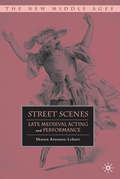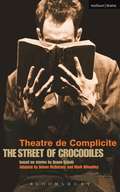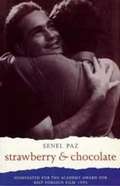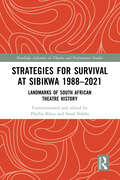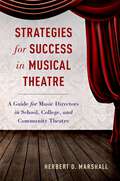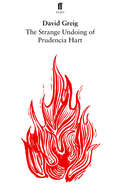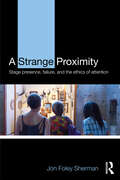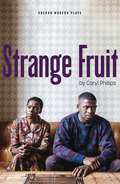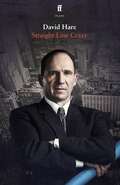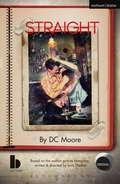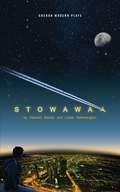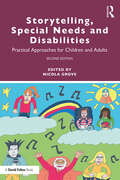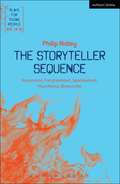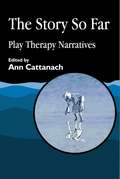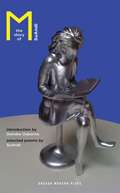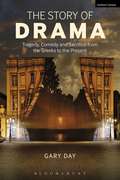- Table View
- List View
Street Scenes: Late Medieval Acting and Performance (The New Middle Ages)
by S. Aronson-LehaviStreet Scenes offers a theory of late medieval acting and performance through a fresh and original reading of the Tretise of Miraclis Pleyinge. The performance theory perspective employed here, along with the examination of actor/character dialectics, paves the way to understanding both religious theatre and the complexity of late medieval theatricalities. Sharon Aronson-Lehavi demonstrates the existence of a late medieval discourse about the double appeal of theatre performance: an artistic medium enacting sacred history while simultaneously referring to the present lives of its creators and spectators.
The Street Of Crocodiles (Modern Plays)
by Bruno Schulz"Complicite not only open our eyes to Bruno Schulz but turn his densely impressionistic stories into a piece of vividly imaginative theatre" (Michael Billington, Guardian)The Street of Crocodiles is inspired by the life and stories of Polish writer Bruno Schulz (1892-1942). Originally co-produced by Théâtre de Complicité and the Royal National Theatre it opened at the Cottesloe in 1992 and toured all over the world until 1994. The original production was remounted in 1998 and played in New York, Toronto, Minneapolis and Tokyo before opening at the Queen's Theatre London in January 1999."This astounding production creates a vision of provincial Poland in the early part of the century as a restless ocean of unending flux...the miracle of Complicite's interpretation of Schulz's stories...is its ability to give specific theatrical life to this perceptual anarchy...when you leave the theatre you expect the ground beneath your feet to give way." (New York Times)
The Street Of Crocodiles: The Street Of Crocodiles And Sanatorium Under The Sign Of The Hourglass (Modern Plays)
by Bruno Schulz"Complicite not only open our eyes to Bruno Schulz but turn his densely impressionistic stories into a piece of vividly imaginative theatre" (Michael Billington, Guardian)The Street of Crocodiles is inspired by the life and stories of Polish writer Bruno Schulz (1892-1942). Originally co-produced by Théâtre de Complicité and the Royal National Theatre it opened at the Cottesloe in 1992 and toured all over the world until 1994. The original production was remounted in 1998 and played in New York, Toronto, Minneapolis and Tokyo before opening at the Queen's Theatre London in January 1999."This astounding production creates a vision of provincial Poland in the early part of the century as a restless ocean of unending flux...the miracle of Complicite's interpretation of Schulz's stories...is its ability to give specific theatrical life to this perceptual anarchy...when you leave the theatre you expect the ground beneath your feet to give way." (New York Times)
Strawberry And Chocolate: Introduction, translations & interview by Peter Bush
by Senel Paz Peter Bush[Amazon] The central relationship between Diego, the gay Cuban intellectual, and David a young communist militant, is developed by writer Senel Paz from his prize-winning short story "The Wolf, the Woods and the New Man". Introduction, translations & interview by Peter Bush
Strategies for Survival at SIBIKWA 1988 – 2021: Landmarks of South African Theatre History (Routledge Advances in Theatre & Performance Studies)
by Phyllis Klotz Smal NdabaThis book provides an engaging and contextualised insight into a South African township-based arts centre that has survived the vicissitudes of steady militarisation in townships during some of the worst years of apartheid as well as the exhilaration of a new democratic policy while attempting to circumnavigate different policies and funding dispensations. Sibikwa provides arts centres across the world and especially those in decolonising countries with strategies for survival in tumultuous times. This multi-disciplinary book maps and co-ordinates wider historical, political, and social contextual concerns and events with matters specific to a community-based east of Johannesburg and provides an exploration and analysis by experts of authentic theatre-making and performance, dance, indigenous music, arts in education and NGO governance. It has contemporary significance and raises important questions regarding inclusivity and transformation, the function and future of arts centres, community-based applied arts practices, creativity, and international partnerships. This study will be of great interest to students and scholars in theatre and performance, indigenous music, dance, and South African history.
Strategies for Survival at SIBIKWA 1988 – 2021: Landmarks of South African Theatre History (Routledge Advances in Theatre & Performance Studies)
by Phyllis Klotz Smal NdabaThis book provides an engaging and contextualised insight into a South African township-based arts centre that has survived the vicissitudes of steady militarisation in townships during some of the worst years of apartheid as well as the exhilaration of a new democratic policy while attempting to circumnavigate different policies and funding dispensations. Sibikwa provides arts centres across the world and especially those in decolonising countries with strategies for survival in tumultuous times. This multi-disciplinary book maps and co-ordinates wider historical, political, and social contextual concerns and events with matters specific to a community-based east of Johannesburg and provides an exploration and analysis by experts of authentic theatre-making and performance, dance, indigenous music, arts in education and NGO governance. It has contemporary significance and raises important questions regarding inclusivity and transformation, the function and future of arts centres, community-based applied arts practices, creativity, and international partnerships. This study will be of great interest to students and scholars in theatre and performance, indigenous music, dance, and South African history.
Strategies for Success in Musical Theatre: A Guide for Music Directors in School, College, and Community Theatre
by Herbert D. MarshallIn Strategies for Success in Musical Theatre, veteran musical director and teacher Herbert Marshall provides an essential how-to guide for teachers or community members who find themselves in charge of music directing a show. Stepping off the podium, Marshall offers practical and often humorous real-world advice on managing auditions; organizing rehearsals; working with a choir, choreographer, and leads; how to run a sitzprobe, a technical rehearsal, and a dress rehearsal; how to manage the cast and crew energy for a successful opening night; and ways to end the experience on a high note for all involved. Throughout the book, Marshall emphasizes the importance of learning through performance and the beauty of a group united in a common goal. In doing so, he turns what can appear as a never-ending list of tasks and demand for specialized knowledge into a manageable, educational, and ultimately engaging and fun experience for all. Because the techniques in Marshall's book have been thoroughly workshopped and classroom tested, they are based in proven pedagogy and will be of particular use for the music director in acting as a teaching director: someone imparting theatrical knowledge to his or her cast and production staff. Marshall provides both extended and abbreviated timelines, flexible to fit any director's needs. Marshall's book is a greatly beneficial resource for music education students and teachers alike, giving an insightful glimpse into the range of possibilities within a music educator's career. Musicians and actors with varying levels of skill and experience will be able to grow simultaneously through Marshall's innovative teaching plans. Through collaborative techniques, steps in the book serve to educate both director and student. Thoroughly illustrated with charts, diagrams, and scores, Strategies for Success in Musical Theatre is an ideal companion for all who work with school and community based musical theater productions.
STRATEG FOR SUCCESS IN MUS THEATRE C: A Guide for Music Directors in School, College, and Community Theatre
by Herbert D. MarshallIn Strategies for Success in Musical Theatre, veteran musical director and teacher Herbert Marshall provides an essential how-to guide for teachers or community members who find themselves in charge of music directing a show. Stepping off the podium, Marshall offers practical and often humorous real-world advice on managing auditions; organizing rehearsals; working with a choir, choreographer, and leads; how to run a sitzprobe, a technical rehearsal, and a dress rehearsal; how to manage the cast and crew energy for a successful opening night; and ways to end the experience on a high note for all involved. Throughout the book, Marshall emphasizes the importance of learning through performance and the beauty of a group united in a common goal. In doing so, he turns what can appear as a never-ending list of tasks and demand for specialized knowledge into a manageable, educational, and ultimately engaging and fun experience for all. Because the techniques in Marshall's book have been thoroughly workshopped and classroom tested, they are based in proven pedagogy and will be of particular use for the music director in acting as a teaching director: someone imparting theatrical knowledge to his or her cast and production staff. Marshall provides both extended and abbreviated timelines, flexible to fit any director's needs. Marshall's book is a greatly beneficial resource for music education students and teachers alike, giving an insightful glimpse into the range of possibilities within a music educator's career. Musicians and actors with varying levels of skill and experience will be able to grow simultaneously through Marshall's innovative teaching plans. Through collaborative techniques, steps in the book serve to educate both director and student. Thoroughly illustrated with charts, diagrams, and scores, Strategies for Success in Musical Theatre is an ideal companion for all who work with school and community based musical theater productions.
The Strange Undoing of Prudencia Hart
by David GreigOne wintry morning academic Prudencia Hart sets off to a conference in the Scottish Borders. Stranded there by snow, she is swept off on a dream-like journey of self discovery, complete with magical moments, devilish encounters and wittily wild music.'You shouldn't miss this for the world . . . Rambunctiously life-affirming and touchingly beautiful.' Herald'More vibrantly alive than any piece of theatre I've seen in Scotland for years.' ScotsmanInspired by the Border ballads, The Strange Undoing of Prudencia Hart toured throughout Scotland in 2011 in a production by the National Theatre of Scotland.
A Strange Proximity: Stage Presence, Failure, and the Ethics of Attention
by Jon Foley ShermanWhat happens in the relationship between audience and performer? What choices are made in the space of performance about how we attend to others? A Strange Proximity examines stage presence as key to thinking about performance and ethics. It is the first phenomenological account of ethics generated from, rather than applied to, contemporary theatrical productions. The ethical possibilities of the stage, argues Jon Foley Sherman, rest not so much in its objects—the performers and the show itself—as in the “how” of attending to others. A Strange Proximity is a unique perspective on the implications of attention in performance.
A Strange Proximity: Stage Presence, Failure, and the Ethics of Attention
by Jon Foley ShermanWhat happens in the relationship between audience and performer? What choices are made in the space of performance about how we attend to others? A Strange Proximity examines stage presence as key to thinking about performance and ethics. It is the first phenomenological account of ethics generated from, rather than applied to, contemporary theatrical productions. The ethical possibilities of the stage, argues Jon Foley Sherman, rest not so much in its objects—the performers and the show itself—as in the “how” of attending to others. A Strange Proximity is a unique perspective on the implications of attention in performance.
Strange Fruit (Oberon Modern Plays)
by Caryl Phillips"I go half way round the world and back thinking I’d made some sort of discovery and come back to find the same damn lies, the same white lies, the same black lies." Alvin and Errol can’t picture much of a future for themselves. They’re young, Black and living in England in the 1980s, with an entire country and political system set against them. Instead they focus firmly on their past – the sunny Caribbean and heroic father they left behind when their mother brought them to England twenty years ago. But when Alvin returns home from his grandfather’s funeral a new version of their past emerges, and the two brothers are caught in a desperate struggle to unearth the truth about their existence. Powerful and compelling, Strange Fruit by Caryl Phillips (winner of the Commonwealth Writers’ Prize) is the story of a family caught between two cultures, and the uncrossable no man’s land that can come between parents and their children.
Straight Line Crazy
by David HareFor forty uninterrupted years, Robert Moses was the most powerful man in New York. Though never elected to office, he manipulated those who were through a mix of guile, charm and intimidation.Motivated at first by a determination to improve the lives of New York City's workers, he created parks, bridges and 627 miles of expressway to connect the people to the great outdoors. But in the 1950s, groups of citizens began to organize against his schemes and against the motor car, campaigning for a very different idea of what a city should be.David Hare's blazing account of a man - played by Ralph Fiennes - whose iron will exposed the weakness of democracy in the face of charismatic conviction, premieres at the Bridge Theatre, London, in March 2022.
Straight (Modern Plays)
by Dc MooreBased on the motion picture Humpday (written & directed in 2009 by Lynn Shelton), Straight is a razor-sharp new comedy from acclaimed writer D. C. Moore about male friendship, sexuality and how the two things can be blurred more easily than one might think . . .Lewis and Waldorf were inseparable at university. Ten years on and a lot has changed. In the middle of a drunken night out, they make a bet that will take their friendship to whole new level. You'll never look at your best friend in the same way again . . .Adapted for the stage by award-winning writer D. C. Moore, author of Town, Honest, Alaska, and The Empire (all published by Methuen Drama) Straight premieres in the Crucible Lyceum Studio, directed by Richard Wilson.
Straight (Modern Plays)
by DC MooreBased on the motion picture Humpday (written & directed in 2009 by Lynn Shelton), Straight is a razor-sharp new comedy from acclaimed writer D. C. Moore about male friendship, sexuality and how the two things can be blurred more easily than one might think . . .Lewis and Waldorf were inseparable at university. Ten years on and a lot has changed. In the middle of a drunken night out, they make a bet that will take their friendship to whole new level. You'll never look at your best friend in the same way again . . .Adapted for the stage by award-winning writer D. C. Moore, author of Town, Honest, Alaska, and The Empire (all published by Methuen Drama) Straight premieres in the Crucible Lyceum Studio, directed by Richard Wilson.
Stowaway (Oberon Modern Plays)
by Hannah Barker Lewis HetheringtonA Boeing 777 begins its descent towards Heathrow. The wheels unfold out of the belly of the plane. The frozen body of a stowaway is tipped out and cuts through the clear morning sky. In the car park of B&Q, Andy looks up. Something is falling out of the sky. A man crash-lands on the ground in front of him. Stowaway is a story about a man from India who finds himself far from home and adrift from everything he knows. He hides in the wheel arch of a commercial airliner bound for the UK, in a bid to change his life. Stowaway is the story of an extraordinary journey in search of an impossible future. But what are the rules of telling someone’s story when they come from a world so different from our own?
Storytelling, Special Needs and Disabilities: Practical Approaches for Children and Adults
by Nicola GroveNow in a fully revised and updated second edition, this innovative and wide-ranging book shows how storytelling can open new worlds for individuals with special educational needs and disabilities. Providing a highly accessible combination of theory and practice, the contributors to this book define their own approaches to inclusive storytelling, describing the principles and theory that underpin their practice, whilst never losing sight of the joy at the heart of their work. Topics include therapeutic storytelling; language and communication; interactive and multi-sensory storytelling; and technology. Each chapter includes top tips, and signposts further training for practitioners who want to start using stories in their own work, making this book a crucial and comprehensive guide to storytelling practice with diverse learners. This new edition: · has been fully updated to reflect the way in which this field of storytelling has grown and developed · uses a broad range of chapters, structured in a way that guides the reader through the conceptualisation of a storytelling approach towards its practical application · includes an additional chapter, sharing the lived experiences of storytellers who identify as having a disability. Full of inspiring ideas to be used with people of all ages and with a range of needs, this book will be an invaluable tool for education professionals, as well as therapists, youth workers, counsellors and theatre practitioners working in special education.
Storytelling, Special Needs and Disabilities: Practical Approaches for Children and Adults
by Nicola GroveNow in a fully revised and updated second edition, this innovative and wide-ranging book shows how storytelling can open new worlds for individuals with special educational needs and disabilities. Providing a highly accessible combination of theory and practice, the contributors to this book define their own approaches to inclusive storytelling, describing the principles and theory that underpin their practice, whilst never losing sight of the joy at the heart of their work. Topics include therapeutic storytelling; language and communication; interactive and multi-sensory storytelling; and technology. Each chapter includes top tips, and signposts further training for practitioners who want to start using stories in their own work, making this book a crucial and comprehensive guide to storytelling practice with diverse learners. This new edition: · has been fully updated to reflect the way in which this field of storytelling has grown and developed · uses a broad range of chapters, structured in a way that guides the reader through the conceptualisation of a storytelling approach towards its practical application · includes an additional chapter, sharing the lived experiences of storytellers who identify as having a disability. Full of inspiring ideas to be used with people of all ages and with a range of needs, this book will be an invaluable tool for education professionals, as well as therapists, youth workers, counsellors and theatre practitioners working in special education.
Storytelling in Participatory Arts with Young People: The Gaps in the Story (Palgrave Studies In Play, Performance, Learning, and Development)
by Catherine HeinemeyerThis book draws on the author’s experience as a storyteller, drama practitioner and researcher, to articulate an emerging dialogic approach to storytelling in participatory arts, educational, mental health, youth theatre, and youth work contexts. It argues that oral storytelling offers a rich and much-needed channel for intergenerational dialogue with young people.The book keeps theory firmly tethered to practice. Section 1, ‘Storyknowing’, traces the history of oral storytelling practice with adolescents across diverse contexts, and brings into clear focus the particular nature of the storytelling exchange and narrative knowledge. Section 2, ‘Telling Stories’, introduces readers to some of the key challenges and possibilities of dialogic storytelling by reflecting on stories from the author’s own arts-based practice research with adolescents, illustrating these with young people’s artistic responses to stories. Finally, section 3, ‘Story Gaps’, conceptualises dialogic storytelling by exploring three different ‘gaps’: the gap between storyteller and listener, the gaps in the story, and the gaps which storytellers can open up within institutions. The book includes chapters taking a special focus on storytelling in schools and in mental health settings, as well as guided reflections for readers to relate the issues raised to their own practice.
The Storyteller Sequence: Karamazoo; Fairytaleheart; Sparkleshark; Moonfleece; Brokenville (Play Anthologies)
by Philip RidleyThis collection brings together Philip Ridley's one-act plays for young people, known as The Storyteller Sequence, ideal for teenagers to either watch or perform.Karamazoo is a fifteen-minute monologue about one of the coolest, most popular kids in the school, whose recent increase in popularity is the direct result of a character make-over following the death of a parent. A witty and moving performance piece for the teenage actor.Fairytaleheart features two fifteen-year-olds, Kirsty and Gideon, who meet for the first time and come to terms with their broken families by sharing their hopes, fears and past experiences - as well as stories - in a derelict community centre. Sparkleshark tells of fourteen-year-old Jake - a victim of bullying and other teenager's mockery - who has to take refuge on the roof of a tower block in order to write his stories. Moonfleece sees Curtis, a young right-wing activist, arrange a meeting in a flat of a derelict tower block where he lived as a child. But his older brother's ghost keeps haunting him. Moonfleece is an intense and thrilling exploration of memory and identity. Brokenville features an unknown disaster, which has left seven characters with little knowledge of who they are or of what has happened. As an old woman and five teenagers begin to act out stories for a mute and frightened child, they begin to discover a little of who they were and what they can be.
The Storyteller Sequence: Karamazoo; Fairytaleheart; Sparkleshark; Moonfleece; Brokenville (Play Anthologies)
by Philip RidleyThis collection brings together Philip Ridley's one-act plays for young people, known as The Storyteller Sequence, ideal for teenagers to either watch or perform.Karamazoo is a fifteen-minute monologue about one of the coolest, most popular kids in the school, whose recent increase in popularity is the direct result of a character make-over following the death of a parent. A witty and moving performance piece for the teenage actor.Fairytaleheart features two fifteen-year-olds, Kirsty and Gideon, who meet for the first time and come to terms with their broken families by sharing their hopes, fears and past experiences - as well as stories - in a derelict community centre. Sparkleshark tells of fourteen-year-old Jake - a victim of bullying and other teenager's mockery - who has to take refuge on the roof of a tower block in order to write his stories. Moonfleece sees Curtis, a young right-wing activist, arrange a meeting in a flat of a derelict tower block where he lived as a child. But his older brother's ghost keeps haunting him. Moonfleece is an intense and thrilling exploration of memory and identity. Brokenville features an unknown disaster, which has left seven characters with little knowledge of who they are or of what has happened. As an old woman and five teenagers begin to act out stories for a mute and frightened child, they begin to discover a little of who they were and what they can be.
The Story So Far: Play Therapy Narratives (PDF)
by Ann CattanachIdentity is formed through the narration of experience, and children who experience difficult life events may need help in forming and expressing their own narratives. Play therapy can be a very appropriate way of facilitating this kind of expression. This book describes the work of nine play therapists through the narratives of children - and some adults - whose stories emerge during their play therapy sessions. These stories are not direct accounts of real happenings but are imaginative, metaphorical, complex and multi-layered. The life events they relate to include fostering, long-term illness, and the traumatic death of a close adult. One chapter examines attachment in families and another describes the Biography Laboratory project exploring story creation through action research. This is a book in which professionals from many disciplines will find much to further their understanding of children's experiences and understanding of the world.
The Story of M (Oberon Modern Plays)
by Deirdre Osborne SuAndiCommissioned by the Institute for Contemporary Arts in 1994, The Story of M has received great critical acclaim in both the United States and Great Britain. The Story of M is SuAndi's moving tribute to the life and death of her mother who raised her mixed-race children in the face of frequent racism in the 1960s but never let them forget they were of African descent and to be proud of their heritages. The play is a solo performance that integrates visual projections and poetic language to portray autobiographical stories of racism, poverty and sacrifice. While sitting in a white screened hospital ward and as slides of family photographs flash all around her, SuAndi travels from the multi-racial Liverpool of the 1920s to life in Britain in the mid-nineties.
The Story of Drama: Tragedy, Comedy and Sacrifice from the Greeks to the Present
by Gary DayTracing the history of tragedy and comedy from their earliest beginnings to the present, this book offers readers an exceptional study of the development of both genres, grounded in analysis of landmark plays and their context. It argues that sacrifice is central to both genres, and demonstrates how it provides a key to understanding the grand sweep of Western drama. For students of literature and drama the volume serves as an accessible companion to over two millennia of drama organised by period, and reveals how sacrifice represents a through-line running from classical drama to today's reality TV and blockbuster movies.Across the chapters devoted to each period, Day explores how the meanings of sacrifice change over time, but never quite disappear. He charts the influences of religion, social change and politics on the status and purposes of theatre in each period, and on the drama itself. But it is through a close study of key plays that he reveals the continuities centred around sacrifice that persist and which illuminate aspects of human psychology and social organisation.Among the many plays and events considered are Aeschylus' trilogy The Oresteia, Aristophanes' Women at the Thesmorphia, Menander's The Bad-Tempered Man, the spectacles of the Roman Games, Seneca's The Trojan Women, Plautus's The Rope, the Cycle plays and Everyman from the Middle Ages, Shakespeare's King Lear and A Midsummer Night's Dream, Middleton's The Revenger's Tragedy, Jonson's Every Man in His Humour, Thomas Otway's The Orphan, William Wycherley's The Country Wife, Wilde's A Woman of No Importance, Beckett' Waiting for Godot, Tennessee Williams's A Streetcar Named Desire, Suzan-Lori Parks's Topdog/Underdog, Sarah Kane's Blasted and Charlotte Jones' Humble Boy. A conclusion examines the persistence of ideas of sacrifice in today's reality TV and blockbuster movies.
The Story of Drama: Tragedy, Comedy and Sacrifice from the Greeks to the Present
by Gary DayTracing the history of tragedy and comedy from their earliest beginnings to the present, this book offers readers an exceptional study of the development of both genres, grounded in analysis of landmark plays and their context. It argues that sacrifice is central to both genres, and demonstrates how it provides a key to understanding the grand sweep of Western drama. For students of literature and drama the volume serves as an accessible companion to over two millennia of drama organised by period, and reveals how sacrifice represents a through-line running from classical drama to today's reality TV and blockbuster movies.Across the chapters devoted to each period, Day explores how the meanings of sacrifice change over time, but never quite disappear. He charts the influences of religion, social change and politics on the status and purposes of theatre in each period, and on the drama itself. But it is through a close study of key plays that he reveals the continuities centred around sacrifice that persist and which illuminate aspects of human psychology and social organisation.Among the many plays and events considered are Aeschylus' trilogy The Oresteia, Aristophanes' Women at the Thesmorphia, Menander's The Bad-Tempered Man, the spectacles of the Roman Games, Seneca's The Trojan Women, Plautus's The Rope, the Cycle plays and Everyman from the Middle Ages, Shakespeare's King Lear and A Midsummer Night's Dream, Middleton's The Revenger's Tragedy, Jonson's Every Man in His Humour, Thomas Otway's The Orphan, William Wycherley's The Country Wife, Wilde's A Woman of No Importance, Beckett' Waiting for Godot, Tennessee Williams's A Streetcar Named Desire, Suzan-Lori Parks's Topdog/Underdog, Sarah Kane's Blasted and Charlotte Jones' Humble Boy. A conclusion examines the persistence of ideas of sacrifice in today's reality TV and blockbuster movies.
